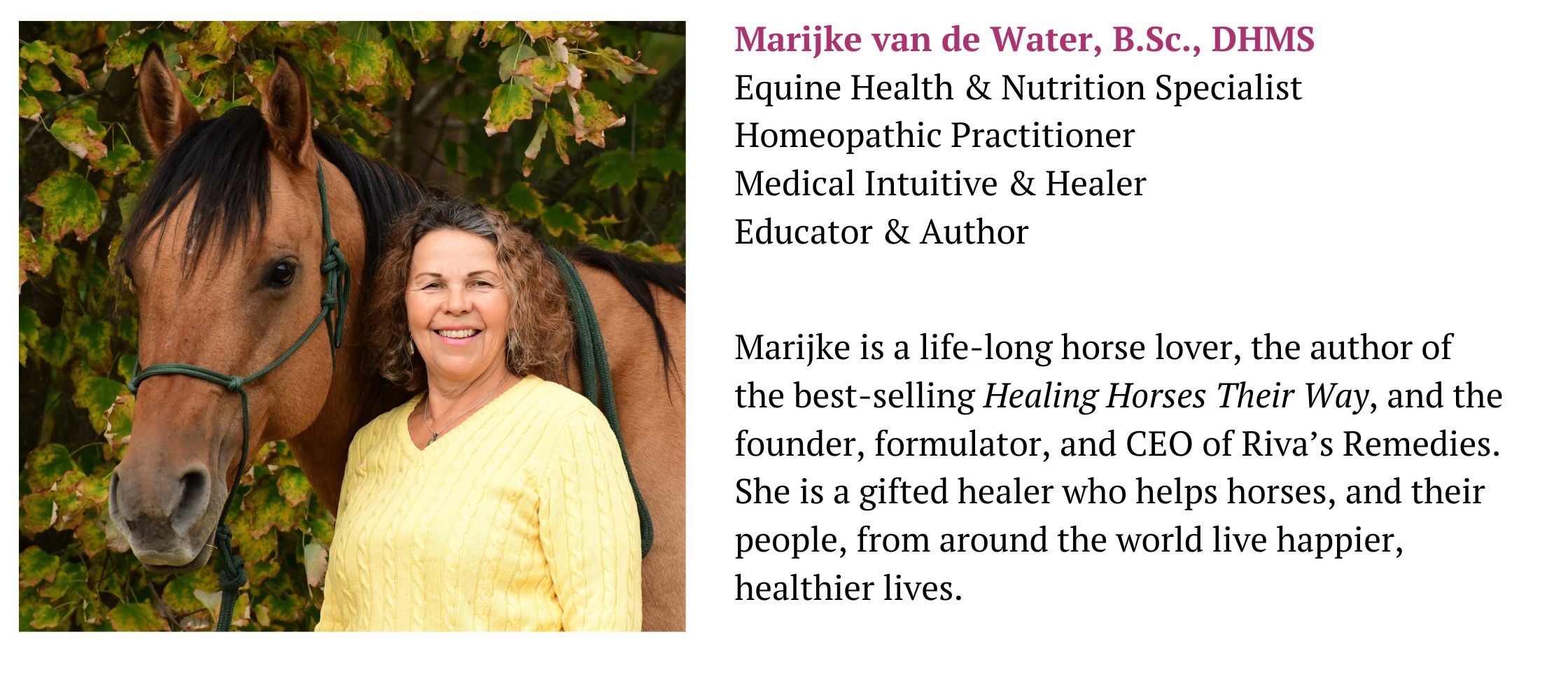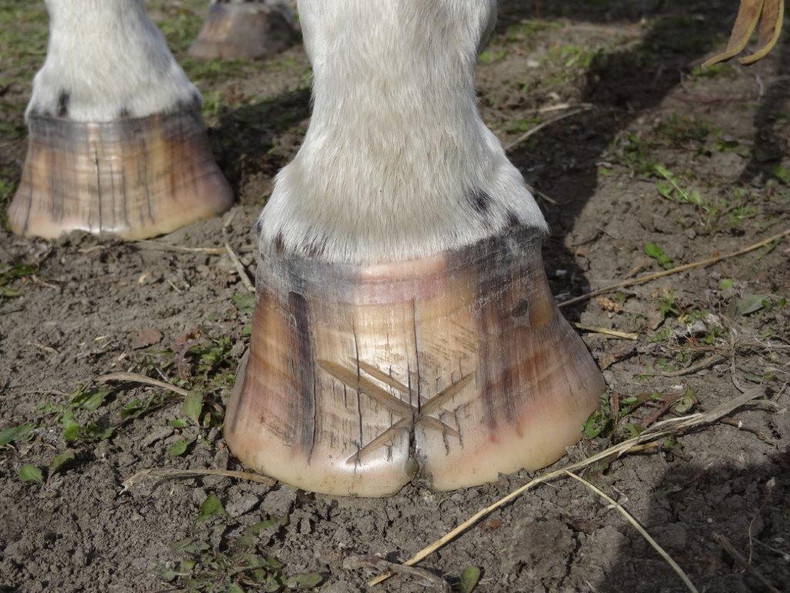The epidemic of laminitis within the horse community is staggering. It is the second leading cause of death in the domestic horse today and we believe it should be the last. So, to get you started on how to prevent and treat hoof problems I have put together a complete list of Do’s and Don’ts to address the root causes of laminitis and provide you with concrete solutions. Post this in your barn for everyone to see!
Have Hope
- DO know that laminitic hooves – without exception - will all heal. Healing requires the right diet, well-selected nutrients, the correction of all underlying health problems, exercise and a professional barefoot trim
- DON’T listen to well-meaning people or professionals who tell you that your horse won’t recover from laminitis – they are misinformed.
Focus on Fibre
- DO feed horses a high fibre diet which may include suitable hay, beet pulp, certain seeds, wheat bran, wheat germ and/or fruit and vegetables. Fibre detoxifies the liver and hindgut, regulates appetite, lowers the glycemic index of all feeds and encourages weight loss.
- DON’T feed high fat feeds or added oils. While current popular opinion promotes feeding horses poor quality fats for “cool” energy and for lowering the glycemic index of forage and grain, fats and oils congest the liver and lymph system, slow down digestive transit time, impede nutrient absorption, contribute to leaky gut, have no nutritional value and increase cortisol levels which elevates blood sugar.
Hay Preparation
- DO use slow feeders to lower stress levels, ease digestion and provide forage 24/7
- DO a hay analysis or ask your hay supplier if they have an analysis available. You will want to know if the levels of sugars, starches, fibre, and protein are acceptable for laminitic or Insulin Resistance horses.
- DON’T soak your hay for longer than two to three weeks – any longer than that could increase hunger and stress levels as the sugar and/or protein levels may become deficient. Any hay that needs to be soaked long-term to maintain weight or soundness is not an appropriate hay. Only soak hay for 40-45 minutes at a time, do not soak overnight, and do not soak in hot water.
Watch Hooves
- DO ensure a proper barefoot trim for optimum hoof function. Educate yourself on what a healthy hoof looks like so you can make comparisons to your own horses’ feet.
- DON’T accept hoof pathologies as normal no matter what you are told: flaring walls, bell-shaped hooves, cracking, splitting, soft soles, flat soles, long toes, high heels, contracted heels and/or under-run heels are all abnormal and can be corrected with a suitable barefoot trim, exercise and an appropriate diet.
- DO educate yourself on sub-clinical laminitis which can occur as either the early or late stage of laminitis but where undetectable structural changes have occurred within the hoof. It is a common cause of hoof soreness and yet is frequently not diagnosed. It is often mistakenly thought to be arthritis, even in young horses.
- DON’T accept the label of “navicular” - this is an over-used term to explain unexplained hoof symptoms. Many cases of so-called navicular are actually caused by the diet, the trim, and lack of exercise.
Control Sugars
- DO use caution with alfalfa. While the high protein levels in alfalfa will lower the glycemic index and stabilize blood sugar in SOME horses, excess or long-term alfalfa will exacerbate laminitic symptoms in most horses by contributing to a leaky gut and/or by increasing the deposition of acids into the hoof joints.
- DON’T feed oats, barley, corn, COB, grains or any other commercial grain feeds including extruded feeds – these are all high in sugar and non-structural carbohydrates which increase blood sugar, insulin levels and cecal acids and toxins (leaky gut) – all major causes of hoof inflammation.
- For metabolic problems read Marijke's blog on Insulin Resistance.
Add Nutrients
- DO make use of therapeutic doses of nutrients which support hoof health. Nutrients such as selenium, silica, sulphur, and vitamin C strengthen the hoof wall, lamina, collagen, and joint capsules.
- DON’T use glucosamine products - glucosamine is a type of sugar that strains the liver and depresses insulin production in sugar sensitive, overweight and/or metabolic horses.
Manage Pain
- DO use pads, boots and/or casts temporarily to relieve pain and to encourage movement in all stages of laminitis.
- DON’T confine a laminitic horse no matter how sore they are – horses need movement and exercise to improve circulation and deliver nutrients to toxic and damaged hoof tissues. Let the sore horse decide how much movement he/she needs. Metabolic horses with laminitis need sufficient exercise to regulate blood sugar levels and to reverse their condition.
Begin Treatment
- DO treat horses for a leaky gut if present – hindgut bacteria, acids and toxins are a major cause of laminitis. Treatment programs include probiotics, herbal cleansers and specific nutrients.
- DON’T starve the overweight laminitic/metabolic horse – this creates stress causing unbalanced insulin levels, increased cortisol production, poor immunity and an increase in hoof inflammation. Make available small amounts of forage 24/7 by using slow feeders.
- DO treat horses for parasites if present – parasitic toxins exacerbate hoof inflammation and/or laminitis.
- DON’T put a laminitic horse on pasture – fresh grass is very high in sugar or fructans, especially in the spring, summer and the hottest part of the day.
Hoof Remedies
Happy Foot herbal blend – 1 tsp, gradually increasing to 1-2 Tbsp - An herbal blend formulated in response to requests from hoof trimming specialists who prefer a natural approach to hoof comfort and mobility. Maintains healthy circulation.
Joint-Clear herbal blend – 2
Tbsp daily - Promotes the health and function of bones, joints, and muscles. Maintains healthy adrenal function, Well suited for senior horses. Combines well with Riva's Bone-Up.
Circu+Plus - Promotes normal hoof circulation and healthy hoof tissue in chronically sore horses. Supports connective tissue and muscle health. Maintains a calm, healthy nervous system.
Above all make a commitment to practice prevention – good food, good trims, good exercise!
We wish you Happy Hooves, Happy Horses and Happy Humans for many years to come!


